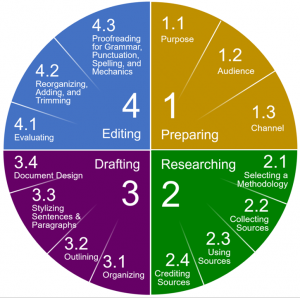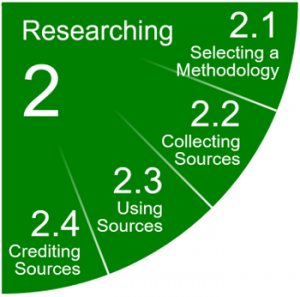Chapter 3: The Writing Process 2: Researching
Learning Objectives
- Determine the appropriate research methodology that meets the needs of the audience.
- Distinguish between formal and informal research.
- Quote source text directly with accuracy and correct punctuation.
- Use effective reading strategies to collect and reframe information from a variety of written materials accurately.
i. Separate main ideas from subordinate ideas in written materials
ii. Identify the organizational structure of a variety of written messages
iii. Read with a purpose to identify needed information
iv. Paraphrase, summarize, and reformat information collected from written materials - Locate, select, and organize relevant and accurate information drawn from a variety of sources appropriate to the task.
i. Select and use databases to find information
ii. Locate prescribed sources of information
iii. Distinguish between primary and secondary sources
iv. Evaluate the relevance and validity of information
v. Assess and choose information sources appropriate to the purpose and task
vi. Compile and organize information - Integrate and document information using commonly accepted citation guidelines.
i. Credit other’s work or ideas to avoid plagiarism
ii. Incorporate research information in written materials and oral messages
iii. Use strategies to identify and avoid plagiarism
iv. Identify acceptable citation guidelines
v. Cite sources correctly
Once you’ve identified your purpose for writing, profiled your audience, and selected the appropriate channel (Stage 1 in the writing process covered in Ch. 2), next you must gather the information that your audience needs. From the shortest informative email to the sprawling analytical report, most professional messages involve relaying information that was looked up—that is, they involve research. Employers value employees who are resourceful, whose research skills go well beyond Google-searching on the internet and focusing on the top few results like anyone can do. Whether such in-demand employees get the needed information from a print book in a library, a manual from a database on a company intranet, an article from a subscription database on the internet, or simply by asking a reputable authority such as a veteran co-worker, they prove their value by knowing where to find valuable information, how to use it appropriately, and how to document it if necessary.


Figure 3: The four-stage writing process and Stage 2 breakdown

